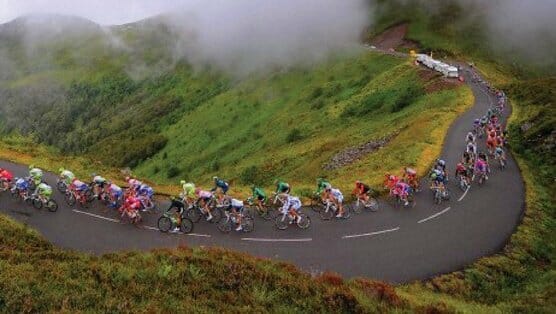Lanterne Rouge: The Last Man in the Tour de France by Max Leonard
Bringing Up the Rear
Books Reviews France
The peloton: It sounds a classical beast, a chimeric maelstrom of short, fanged feet and raging lungs, gnashing teeth and sawing limbs, leaving the broken dreams and machines of the finest men in its wake.
The peloton is the great pack of huddled cyclists whipping around whatever godforsaken corner of race course these animate skeletons have the greatest blessing and curse of propelling themselves through. It is the dangerous, many-limbed, many-wheeled core of the race.
 Away from the dramatic ball lay the escape artists, the smaller, swifter packs battling amongst each other to propel one of their own, their chosen one, to victory in the race. And well behind the pushing, heaving mass are the stragglers, the world class made seemingly pedestrian, by virtue of injury, technical difficulty, force majeur, calamity or simply being out of their depth. And finally, behind all of these, there is the lanterne rouge.
Away from the dramatic ball lay the escape artists, the smaller, swifter packs battling amongst each other to propel one of their own, their chosen one, to victory in the race. And well behind the pushing, heaving mass are the stragglers, the world class made seemingly pedestrian, by virtue of injury, technical difficulty, force majeur, calamity or simply being out of their depth. And finally, behind all of these, there is the lanterne rouge.
The lanterne rouge—named, most likely, for the red lights hung from the back of a train’s final car—is the traditional, albeit unofficial, honorific bestowed upon the last man in the Tour de France. He is, by the cruelest definition, the Tour’s loser, although scores of riders will have dropped out before him. He is also, by any definition, a world class champion and veritable demigod compared to pretty much everyone you know (unless your coterie includes numerous professional road cyclists). His sheer survival is impressive when you consider the blood and mountains and cruel heat he has overcome, to say nothing of his own mind and damned failing legs.
In studying these riders, Max Leonard demonstrates that perhaps the best way to understand the Tour de France—and, to an extent, cycling as a whole—is to approach it was most of us would on a bike: from well behind. Lanterne Rouge: The Last Man in the Tour de France is equal parts history, hagiography, love letter and existential rumination. It is also quite good, insomuch as it falls well within the wheel grooves of the similar sports books before it but then drafts behind them, like a skilled racer does, so that its heart-on-sleeve moments, which can become syrupy quagmires in lesser reads, hurtle by, driven by Leonard’s relatively lean prose and his obvious personal passion.
Leonard compresses over a century of racing history, keying in on representative lanterns to illustrate the Tour, the sport and the peculiar philosophy of losing. There are the Basque brothers, who made the red light a family heirloom; the man for whom drugs and doping did not lead to a podium, but to a lanterne rouge and, eventually death; the Frenchman who won stages and hearts while losing the race; the North African who ran up against a tree and history. In short, there is just as much drama, romance and good old fashioned triumph-of-the-human-spirit to be found on the opposite end of the list, perhaps even more so.
Meticulous research and, when possible, in-person interviews bring each racer and his Tour to life. Indeed, one of the book’s main problems is the ability of any reader who is not already steeped in Tour lore to keep track of the rotating cast Leonard is forever introducing. His lodestar lanterns are never examined sans context, which allows for him to explore entire epochs, and while the read is never slow or boring—it is astonishing, really, how Leonard keeps the whole thing moving, animated by the pure heart and joy of a lover without the didactics—it can be cause, every once in a while, for confusion.
But all of that is overshadowed by the grand history of the race Leonard chronicles, and what a confusing race it is! The Tour de France is a single sporting event with the complexity of entire sporting codes. It’s composed of numerous types of athletes—climbers, sprinters, domestiques, time trialists—and spans almost unimaginable stretches of time and distance, dwarfing the marathon and even auto races. It is something so incredibly difficult that to survive it at all is an accomplishment; it is not without good reason that the Tour de France ends in heaven.
From the race’s early, wild days to its Great War renaissance and into the modern, doping and post-doping eras, Leonard finds within the lanterns both the spiritual qualities with which we load sport—the gamesmanship, the bravery, the camaraderie—and the refreshingly practical, “Tracy Austin Broke My Heart” style platitudinal mind that exists within the premiere athlete. His lanterns are not quite people, but they are just a bit closer, and that humanity is what shines through, like the red lantern of a night train’s caboose.
B. David Zarley is a freelance journalist, essayist and book/music/art critic currently based in Chicago. A former book critic for The Myrtle Beach Sun News, his work can be seen in VICE, VICE Sports, Pitchfork, Sports on Earth, The Classical and New American Paintings, among numerous other publications. You can find him on Twitter or at his website.